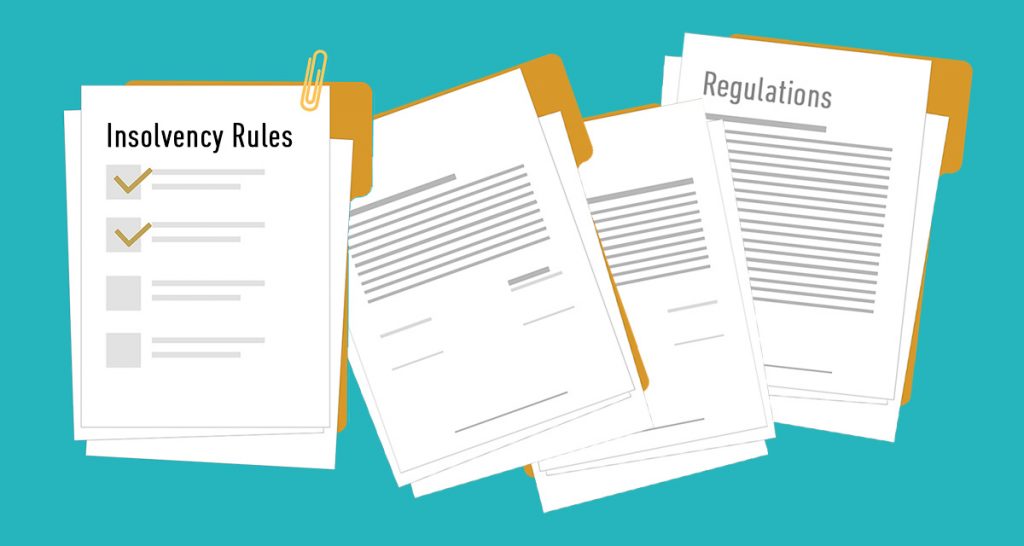Creditors’ Guide to the Insolvency Rules 2016
Tue 18 Apr 2017
The Insolvency (England and Wales) Rules 2016 (“the Rules”) came into force on 6 April 2017 and aim to:
- Consolidate the law;
- increase creditor engagement by encouraging “21st century” communication; and
- remove administrative burdens that add no value for creditors.
The Rules look very different, both in terms of language, which has been modernised and made gender neutral, and in terms of layout, introducing common parts to the Rules.
 Creditors’ Meetings
Creditors’ Meetings
The requirement to hold physical meetings to agree creditors’ resolutions in all insolvency proceedings has been removed except where creditors request a meeting. This can only be actioned under a new “10/10/10” rule. This is 10% by value of claims/10% by number of creditors/10 creditors (in number). Otherwise, physical meetings have been replaced by a range of decision-making procedures.
Decision Procedures
Various decision making procedures have been introduced, including:
- deemed consent (see below);
- correspondence;
- electronic voting;
- virtual meetings; and
- any other procedure which enables all entitled creditors to participate.
The Insolvency Practitioner is generally able to choose which decision procedure to use in respect of the relevant resolution being sought, subject to specific caveats.
The notice sent to creditors seeking the resolutions must contain prescribed information relating to the decision being sought with guidance notes detailing the decision making procedure being followed.
Deemed Consent
Deemed consent is a decision procedure that does not require a positive response from creditors. It allows for notice of a decision to be given to creditors and, unless a minimum of 10% in value of creditors object, the decision is treated as having been approved. The decision is deemed to have been passed at 11:59pm on the decision date and creditors have up until that time to formally object. Should more than 10% in value of the creditors’ object, the Insolvency Practitioner must seek the decision by a different decision procedure.
The deemed consent procedure cannot be used in certain circumstances, including any decisions relating to remuneration of the Insolvency Practitioner or the approval of Voluntary Arrangements.
Interestingly, the deemed consent procedure can be used to appoint a Liquidator in a Creditors’ Voluntary Liquidation, although the basis of their remuneration will have to be agreed by a different decision procedure.
Communication/Opting Out
Email
As part of the general modernisation of the insolvency legislation, formal provision has been made to enable communication with creditors by email, either where a creditor expressly agrees or where agreement is deemed to have occurred due to a history of communicating with the insolvent entity by this method.
Websites
The use of websites to deliver information to creditors has also been extended. Now, an Insolvency Practitioner will be able to write to creditors advising them that all future correspondence will be placed on a website. Creditors will be able to log on to the website to retrieve all correspondence during the lifetime of the administration of the case. They should be aware, however, that the Insolvency Practitioner will not notify them when new reports are uploaded, so the onus will be on the creditor to check for updates on a regular basis.
Opting Out
Creditors can also now elect to “opt out” of receiving communication on a particular insolvency case. Where the Insolvency Practitioner has elected to use a website to deliver communications to creditors, there would appear to be little point in opting out, otherwise this is an option. However, a creditor cannot opt out of all communication. For example, notice of intended dividends must still be sent to all creditors.
Proving Your Debt
Proof of Debt Forms
Whilst the new Rules have abolished the use of statutory forms, they have introduced a list of prescribed content for certain documents, including a proof of debt. It is likely therefore that a set of “standard” documents will be used to ensure all of the required content is included. A standard proof of debt document will be required on all cases going forward (subject to some exceptions) not just on Bankruptcy and Compulsory Liquidation cases.
Claims of £1,000 or less
Creditors will not longer have to formally prove for a debt of £1,000 or less. An Insolvency Practitioner may now advise creditors whose claims are £1,000 or less that they are deemed to be agreed without any further documentation being required. This will be based on the level of debt detailed on the Statement of Affairs or records produced by the insolvent entity. Where a creditor receives such a notice, but their debt is different to the amount stated, they should respond promptly with a proof of debt to correct the position.
Revaluing Security
A secured creditor will now be able to revalue its security with the agreement of the Insolvency Practitioner and will no longer require Court sanction.
Summary
The new Rules represent the biggest reform to insolvency legislation in nearly 30 years. Creditors need to be aware of the changes if they want to engage in the insolvency process. The use of the new deemed consent procedure is likely to become of the of the most commonly used new tools for decision making, so creditors should be alive to this and act promptly if they have any objections to the decisions being sought.
Should you have any queries about the new Rules, please do not hesitate to contact a member of the Restructuring Services team who will be pleased to assist.












Comments